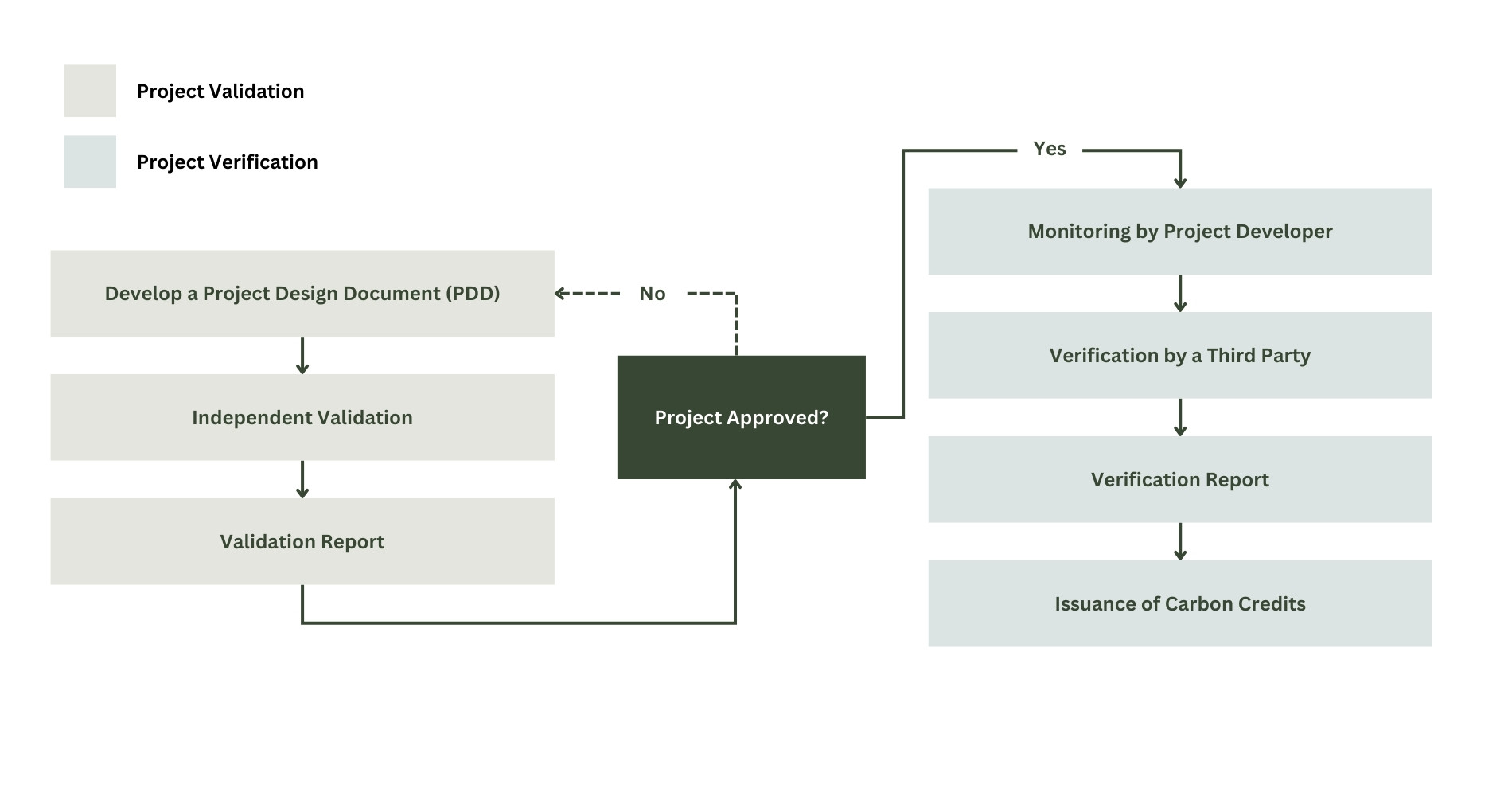The world of carbon credits is filled with a plethora of abbreviations and acronyms, making it challenging to grasp both the basics and the intricacies of the voluntary carbon market (VCM). However, understanding these concepts is crucial, especially as the VCM has great potential to play a significant role in global efforts to combat climate change.
What Are Carbon Credits and Why Are They Important?

A carbon credit represents one metric tonne of carbon dioxide (CO₂) or its equivalent (CO₂e) that has been removed or avoided from entering the atmosphere. These credits are essential tools in climate action strategies, allowing individuals and businesses to offset their carbon emissions by funding these projects.
Carbon credits are categorised into two types:
1. Removal Carbon Credits: These are linked to activities that directly remove carbon from the atmosphere, such as reforestation or enhanced rock weathering projects.
2. Avoidance / Reduction Carbon Credits: These relate to activities that prevent emissions from being released, such as renewable energy projects that displace fossil fuel use.
Additionality, a core tenet of what makes a good carbon credit, ensures that each carbon offset project contributes to genuine, measurable environmental benefits beyond what would otherwise naturally occur.
Learn more about the difference between carbon removal vs. carbon avoidance credits here.
Who Verifies Carbon Credits and What Is the Verification Process?

Ensuring the credibility of carbon credits is critical for maintaining trust in the carbon market. This is achieved through a rigorous and structured process involving both project validation and project verification. Here’s a quick overview of these processes:
1. Project Validation
Objective: To assess whether a proposed project meets the criteria required to generate carbon credits.
– Developing a Project Design Document (PDD): The project developer prepares a PDD, which includes details such as the project’s scope, baseline scenario also known as the ‘counterfactual’ (what emissions would be without the project), methodologies for measuring emissions reductions, and monitoring plans.
– Independent Validation: An independent third-party auditor reviews the PDD. These entities are typically accredited by recognised bodies like the United Nations Framework Convention on Climate Change (UNFCCC). The validator assesses whether the project complies with the relevant standards and methodologies and whether it is likely to result in genuine, additional (beyond business as usual) emissions reductions or removals.
– Validation Report: After reviewing the PDD and providing feedback, the validator issues a validation report, which either approves the project or requires further modifications before it can proceed.
2. Project Verification
Objective: To confirm that the project is achieving the claimed emissions reductions or removals.
– Monitoring: The project developer monitors the project’s emissions reductions or removals in accordance with the plan outlined in the PDD. This involves collecting data on various indicators, depending on the project type.
– Verification by a Third Party: An accredited verifier, different from the validator, is engaged to independently assess the monitoring data. The verifier conducts site visits, audits the data and evaluates the project’s performance against the claims made.
– Verification Report: The verifier produces a verification report detailing the findings. This report confirms the amount of emissions reductions or removals achieved, which determines the number of carbon credits that can be issued. If discrepancies or issues are found, they must be resolved before credits can be issued.
– Issuance of Carbon Credits: Once the verification is complete and the reductions or removals are certified, the relevant authority or registry issues carbon credits to the project developer, which can then be traded or sold.
What Standards Are Used for Verifying Carbon Credits?
The verification of carbon credits is governed by internationally recognised standards, which ensure consistency, transparency, and accuracy. Some of the most prominent standards include:
– The Verified Carbon Standard (VCS): Administered by Verra, it is one of the most widely used standards for verifying voluntary carbon credits.
– The Gold Standard: Initially developed for Clean Development Mechanism (CDM) projects, it emphasises not only carbon reductions but also sustainable development impacts.
– The Climate Action Reserve (CAR): Focuses on high-quality offset projects in North America, providing a robust protocol for verification.
– The American Carbon Registry (ACR): Another widely respected standard, particularly for projects in the United States.
Increasingly, new standards are entering the market in an effort to raise the quality of credits found on the VCM by employing rigorous verification processes and focusing solely on carbon removal activities. These include:
– Puro Standard: One of the world’s leading crediting standards for engineered carbon removal.
– Isometric: The latest standard to focus on verifying and crediting long-duration carbon removal.
All of these standards provide detailed methodologies and guidelines for measuring, reporting, and verifying carbon reductions or removals, ensuring that what is claimed is real, measurable, and additional (i.e., they wouldn’t have occurred without the project). Additionally, registries often provide public access to information about projects and credits that have been issued to ensure transparency and accountability.
Why Is Third-Party Verification Critical in the Carbon Credit Market?

Third-party verification is crucial for maintaining the integrity of the carbon market. Independent auditors provide an objective assessment of a project’s emissions reductions, which helps prevent fraud and overstatement of carbon credits. This transparency builds trust among buyers, ensuring that the credits they purchase represent genuine environmental benefits.
Challenges in the Verification of Carbon Credits
Despite the robust frameworks in place, the verification of carbon credits faces several challenges:
– Data Availability: Accurate measurement depends on reliable data, which can be difficult to obtain, especially in remote or underdeveloped areas.
– Complexity of Projects: Some projects, particularly those involving new technologies or complex ecosystems, pose challenges in measuring and verifying emissions reductions.
– Costs: The verification process can be costly and time-consuming, which can be a barrier for smaller projects.
The Impact of Verified Carbon Credits on Climate Action

Verified carbon credits are a key mechanism in the global response to climate change and a necessary tool for businesses aspiring to achieve net zero. By providing financial incentives for emission reduction and removal projects, they help to:
– Accelerate the transition to a low-carbon economy: by funding renewable energy, energy efficiency, and sustainable land use projects.
– Enhance global carbon accounting and transparency: enabling more accurate tracking of progress toward climate targets.
– Foster sustainable development: by supporting projects that also deliver social and environmental co-benefits, such as biodiversity conservation and community health improvements.
Therefore, not only is the verification of carbon credits a critical component to ensure the credibility and effectiveness of the voluntary carbon market and the fight against climate change but understanding what kind of activity is being verified is also hugely important. Adhering to rigorous standards and mandating independent third-party auditors will certainly instil greater trust.
Yet the question remains as to whether carbon removal credits should be used instead of avoidance/reduction credits for corporate offsetting purposes when decarbonisation efforts have been exhausted. As this debate rolls on and the market grows, overcoming the challenges in verification will be key to maintaining its integrity and success.
 " alt="">
" alt="">
At UNDO, Bea leverages insights to shape carbon products and develop crucial data management for carbon credits. Previously, she founded a conscious consumerism platform, participated in an Entrepreneur Residency, and earned an MSc in Carbon Management from the University of Edinburgh, propelling her into carbon removal and dedicating her career to this cause.


 " />
" />
